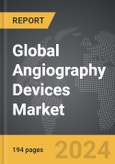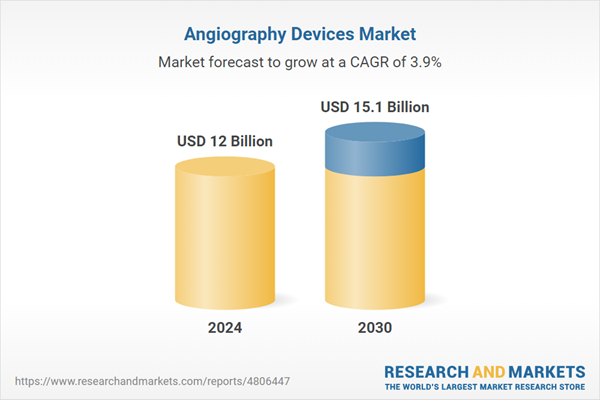The global market for Angiography Devices was valued at US$12.0 Billion in 2024 and is projected to reach US$15.1 Billion by 2030, growing at a CAGR of 3.9% from 2024 to 2030. This comprehensive report provides an in-depth analysis of market trends, drivers, and forecasts, helping you make informed business decisions. The report includes the most recent global tariff developments and how they impact the Angiography Devices market.
Segments: End-Use (Hospitals & Clinics, Diagnostic & Imaging Centers, Research Institutes); Procedure (Coronary Angiography, Endovascular Angiography, Neuroangiography, Onco-Angiography, Other Angiography Procedures); Product (Angiography Systems, Angiography Contrast Media, Vascular Closure Devices, Angiography Balloons, Angiography Catheters, Angiography Guidewires, Angiography Accessories); Technology (X-Ray Angiography, CT Angiography, MR Angiography, Other Angiography Technologies).
Geographic Regions/Countries: World; United States; Canada; Japan; China; Europe (France; Germany; Italy; United Kingdom; Spain; Russia; and Rest of Europe); Asia-Pacific (Australia; India; South Korea; and Rest of Asia-Pacific); Latin America (Argentina; Brazil; Mexico; and Rest of Latin America); Middle East (Iran; Israel; Saudi Arabia; United Arab Emirates; and Rest of Middle East); and Africa.
The analysts continuously track trade developments worldwide, drawing insights from leading global economists and over 200 industry and policy institutions, including think tanks, trade organizations, and national economic advisory bodies. This intelligence is integrated into forecasting models to provide timely, data-driven analysis of emerging risks and opportunities.
Global Angiography Devices Market - Key Trends & Drivers Summarized
Why Is the Demand for Angiography Devices Surging in Cardiovascular Healthcare?
Angiography devices are experiencing a surge in demand, driven primarily by the increasing prevalence of cardiovascular diseases (CVD) globally. As heart disease remains a leading cause of mortality worldwide, diagnostic procedures like angiography, which provide detailed images of blood vessels, are critical for early detection and treatment. The aging global population, along with unhealthy lifestyle habits such as poor diet and lack of exercise, has led to a rise in conditions like atherosclerosis, stroke, and coronary artery disease. Consequently, the need for reliable diagnostic tools, including angiography systems, is becoming more pronounced in both developed and developing regions. This growth is further supported by healthcare systems emphasizing preventive care and early diagnosis to mitigate the rising costs of treating advanced CVD.How Is Technology Revolutionizing the Angiography Devices Market?
Technological advancements are playing a pivotal role in enhancing the capabilities of angiography devices, making them more efficient and safer for patients. One major development is the integration of digital imaging technology, which allows for higher-resolution images and real-time monitoring during procedures. The use of 3D and 4D imaging systems is transforming the way cardiologists assess blood vessels and coronary blockages, enabling more precise interventions. Another innovation is the development of minimally invasive catheter-based angiography systems, which reduce patient recovery times and minimize risks associated with traditional invasive angiography. These technological improvements are not only enhancing diagnostic accuracy but also expanding the scope of angiography into peripheral vascular conditions and neurology, thereby broadening the market's reach.What Role Do Regulations Play in the Adoption of Angiography Devices?
Stringent regulatory requirements are critical to the angiography devices market, as patient safety is paramount in cardiovascular interventions. Regulatory bodies like the FDA and European CE mark demand rigorous testing and validation of these devices to ensure they meet safety and performance standards. These regulations are particularly important given the risks associated with angiographic procedures, such as radiation exposure and contrast-induced nephropathy. Manufacturers are under pressure to develop devices that minimize these risks while complying with strict guidelines. Furthermore, advancements in imaging technologies and the development of contrast-free angiography techniques are being driven by regulatory encouragement, further shaping the future of the market. Compliance with these standards ensures widespread adoption of new, safer angiography systems across global healthcare settings.What Factors Are Propelling the Growth of the Angiography Devices Market?
The growth in the angiography devices market is driven by several factors, including the rising incidence of cardiovascular diseases, increasing awareness of early diagnostic tools, and advancements in imaging technology. The growing elderly population, who are more prone to heart-related ailments, has significantly boosted demand for angiography procedures. In addition, technological advancements, such as the introduction of hybrid operating rooms that combine surgical and diagnostic functions, are enhancing the efficiency and accuracy of cardiovascular interventions, thereby increasing the demand for state-of-the-art angiography systems. Expanding healthcare infrastructure in emerging markets, coupled with increased government investment in healthcare technologies, is also driving growth. Finally, the growing preference for minimally invasive procedures has accelerated the adoption of newer, safer angiography devices across a range of medical specialties.Report Scope
The report analyzes the Angiography Devices market, presented in terms of units. The analysis covers the key segments and geographic regions outlined below.Segments: End-Use (Hospitals & Clinics, Diagnostic & Imaging Centers, Research Institutes); Procedure (Coronary Angiography, Endovascular Angiography, Neuroangiography, Onco-Angiography, Other Angiography Procedures); Product (Angiography Systems, Angiography Contrast Media, Vascular Closure Devices, Angiography Balloons, Angiography Catheters, Angiography Guidewires, Angiography Accessories); Technology (X-Ray Angiography, CT Angiography, MR Angiography, Other Angiography Technologies).
Geographic Regions/Countries: World; United States; Canada; Japan; China; Europe (France; Germany; Italy; United Kingdom; Spain; Russia; and Rest of Europe); Asia-Pacific (Australia; India; South Korea; and Rest of Asia-Pacific); Latin America (Argentina; Brazil; Mexico; and Rest of Latin America); Middle East (Iran; Israel; Saudi Arabia; United Arab Emirates; and Rest of Middle East); and Africa.
Key Insights:
- Market Growth: Understand the significant growth trajectory of the Angiography Systems segment, which is expected to reach US$5.8 Billion by 2030 with a CAGR of a 5.2%. The Angiography Contrast Media segment is also set to grow at 3.8% CAGR over the analysis period.
- Regional Analysis: Gain insights into the U.S. market, valued at $3.1 Billion in 2024, and China, forecasted to grow at an impressive 6.8% CAGR to reach $3.5 Billion by 2030. Discover growth trends in other key regions, including Japan, Canada, Germany, and the Asia-Pacific.
Why You Should Buy This Report:
- Detailed Market Analysis: Access a thorough analysis of the Global Angiography Devices Market, covering all major geographic regions and market segments.
- Competitive Insights: Get an overview of the competitive landscape, including the market presence of major players across different geographies.
- Future Trends and Drivers: Understand the key trends and drivers shaping the future of the Global Angiography Devices Market.
- Actionable Insights: Benefit from actionable insights that can help you identify new revenue opportunities and make strategic business decisions.
Key Questions Answered:
- How is the Global Angiography Devices Market expected to evolve by 2030?
- What are the main drivers and restraints affecting the market?
- Which market segments will grow the most over the forecast period?
- How will market shares for different regions and segments change by 2030?
- Who are the leading players in the market, and what are their prospects?
Report Features:
- Comprehensive Market Data: Independent analysis of annual sales and market forecasts in US$ Million from 2024 to 2030.
- In-Depth Regional Analysis: Detailed insights into key markets, including the U.S., China, Japan, Canada, Europe, Asia-Pacific, Latin America, Middle East, and Africa.
- Company Profiles: Coverage of players such as Abbott Laboratories, Inc., AngioDynamics, Inc., B. Braun Melsungen AG, Boston Scientific Corporation, Canon Medical Systems Corporation and more.
- Complimentary Updates: Receive free report updates for one year to keep you informed of the latest market developments.
Some of the 42 companies featured in this Angiography Devices market report include:
- Abbott Laboratories, Inc.
- AngioDynamics, Inc.
- B. Braun Melsungen AG
- Boston Scientific Corporation
- Canon Medical Systems Corporation
- Cordis Corporation
- GE Healthcare
- Koninklijke Philips NV
- Medtronic PLC
- Shimadzu Corporation
- Siemens Healthineers
Tariff Impact Analysis: Key Insights for 2025
Global tariff negotiations across 180+ countries are reshaping supply chains, costs, and competitiveness. This report reflects the latest developments as of April 2025 and incorporates forward-looking insights into the market outlook.The analysts continuously track trade developments worldwide, drawing insights from leading global economists and over 200 industry and policy institutions, including think tanks, trade organizations, and national economic advisory bodies. This intelligence is integrated into forecasting models to provide timely, data-driven analysis of emerging risks and opportunities.
What’s Included in This Edition:
- Tariff-adjusted market forecasts by region and segment
- Analysis of cost and supply chain implications by sourcing and trade exposure
- Strategic insights into geographic shifts
Buyers receive a free July 2025 update with:
- Finalized tariff impacts and new trade agreement effects
- Updated projections reflecting global sourcing and cost shifts
- Expanded country-specific coverage across the industry
Table of Contents
I. METHODOLOGYII. EXECUTIVE SUMMARY2. FOCUS ON SELECT PLAYERSIII. MARKET ANALYSISCANADAITALYSPAINRUSSIAREST OF EUROPESOUTH KOREAREST OF ASIA-PACIFICARGENTINABRAZILMEXICOREST OF LATIN AMERICAIRANISRAELSAUDI ARABIAUNITED ARAB EMIRATESREST OF MIDDLE EASTIV. COMPETITION
1. MARKET OVERVIEW
3. MARKET TRENDS & DRIVERS
4. GLOBAL MARKET PERSPECTIVE
UNITED STATES
JAPAN
CHINA
EUROPE
FRANCE
GERMANY
UNITED KINGDOM
ASIA-PACIFIC
AUSTRALIA
INDIA
LATIN AMERICA
MIDDLE EAST
AFRICA
Companies Mentioned (Partial List)
A selection of companies mentioned in this report includes, but is not limited to:
- Abbott Laboratories, Inc.
- AngioDynamics, Inc.
- B. Braun Melsungen AG
- Boston Scientific Corporation
- Canon Medical Systems Corporation
- Cordis Corporation
- GE Healthcare
- Koninklijke Philips NV
- Medtronic PLC
- Shimadzu Corporation
- Siemens Healthineers
Table Information
| Report Attribute | Details |
|---|---|
| No. of Pages | 194 |
| Published | April 2025 |
| Forecast Period | 2024 - 2030 |
| Estimated Market Value ( USD | $ 12 Billion |
| Forecasted Market Value ( USD | $ 15.1 Billion |
| Compound Annual Growth Rate | 3.9% |
| Regions Covered | Global |









